On-Chip Silicon Photonic Neural Networks Based on Thermally Tunable Microring Resonators for Recognition Tasks
Abstract
1. Introduction
2. Principles and Methods
3. Results and Discussion
3.1. Device Design and Fabrication
3.2. Matrix Multiplication
3.3. Recognition Tasks
3.4. Multilayer Neural Network
4. Conclusions
Author Contributions
Funding
Institutional Review Board Statement
Informed Consent Statement
Data Availability Statement
Conflicts of Interest
References
- Hashem, I.A.T.; Yaqoob, I.; Anuar, N.B.; Mokhtar, S.; Gani, A.; Khan, S.U. The rise of “big data” on cloud computing: Review and open research issues. Inform. Syst. 2015, 47, 98–115. [Google Scholar] [CrossRef]
- Reddy, V.D.; Setz, B.; Rao, G.S.V.R.K.; Gangadharan, G.R.; Aiello, M. Metrics for Sustainable Data Centers. IEEE Trans. Sustain. Comput. 2017, 2, 290–303. [Google Scholar] [CrossRef]
- Peng, H.-T.; Nahmias, M.A.; de Lima, T.F.; Tait, A.N.; Shastri, B.J. Neuromorphic Photonic Integrated Circuits. IEEE J. Sel. Top. Quantum Electron. 2018, 24, 1–15. [Google Scholar] [CrossRef]
- Lynch, C. How do your data grow? Nature 2008, 455, 28–29. [Google Scholar] [CrossRef]
- de Lima, T.F.; Shastri, B.J.; Tait, A.N.; Nahmias, M.A.; Prucnal, P.R. Progress in neuromorphic photonics. Nanophotonics 2017, 6, 577–599. [Google Scholar] [CrossRef]
- Merolla, P.A.; Arthur, J.V.; Alvarez-Icaza, R.; Cassidy, A.S.; Sawada, J.; Akopyan, F.; Jackson, B.L.; Imam, N.; Guo, C.; Nakamura, Y.; et al. A million spiking-neuron integrated circuit with a scalable communication network and interface. Science 2014, 345, 668–673. [Google Scholar] [CrossRef]
- Benjamin, B.V.; Gao, P.; McQuinn, E.; Choudhary, S.; Chandrasekaran, A.R.; Bussat, J.M.; Alvarez-Icaza, R.; Arthur, J.V.; Merolla, P.A.; Boahen, K. Neurogrid: A Mixed-Analog-Digital Multichip System for Large-Scale Neural Simulations. Proc. IEEE 2014, 102, 699–716. [Google Scholar] [CrossRef]
- Schemmel, J.; Brüderle, D.; Grübl, A.; Hock, M.; Meier, K.; Millner, S. A wafer-scale neuromorphic hardware system for large-scale neural modeling. In Proceedings of the 2010 IEEE International Symposium on Circuits and Systems (ISCAS), Paris, France, 30 May–2 June 2010; pp. 1947–1950. [Google Scholar]
- Shastri, B.J.; Tait, A.N.; de Lima, T.F.; Pernice, W.H.P.; Bhaskaran, H.; Wright, C.D.; Prucnal, P.R. Photonics for artificial intelligence and neuromorphic computing. Nat. Photon. 2021, 15, 102–114. [Google Scholar] [CrossRef]
- Kitayama, K.-I.; Notomi, M.; Naruse, M.; Inoue, K.; Kawakami, S.; Uchida, A. Novel frontier of photonics for data processing—Photonic accelerator. APL Photon. 2019, 4, 090901. [Google Scholar] [CrossRef]
- Caulfield, H.J.; Dolev, S. Why future supercomputing requires optics. Nat. Photon. 2010, 4, 261–263. [Google Scholar] [CrossRef]
- Kuramochi, E.; Nozaki, K.; Shinya, A.; Takeda, K.; Sato, T.; Matsuo, S.; Taniyama, H.; Sumikura, H.; Notomi, M. Large-scale integration of wavelength-addressable all-optical memories on a photonic crystal chip. Nat. Photon. 2014, 8, 474–481. [Google Scholar] [CrossRef]
- Kravtsov, K.; Fok, M.P.; Rosenbluth, D.; Prucnal, P.R. Ultrafast all-optical implementation of a leaky integrate-and-fire neuron. Opt. Express 2011, 19, 2133–2147. [Google Scholar] [CrossRef]
- Duport, F.; Schneider, B.; Smerieri, A.; Haelterman, M.; Massar, S. All-optical reservoir computing. Opt. Express 2012, 20, 22783–22795. [Google Scholar] [CrossRef]
- Stelzer, F.; Röhm, A.; Vicente, R.; Fischer, I.; Yanchuk, S. Deep neural networks using a single neuron: Folded-in-time architecture using feedback-modulated delay loops. Nat. Commun. 2021, 12, 5164. [Google Scholar] [CrossRef] [PubMed]
- Xiang, S.; Ren, Z.; Song, Z.; Zhang, Y.; Guo, X.; Han, G.; Hao, Y. Computing Primitive of Fully VCSEL-Based All-Optical Spiking Neural Network for Supervised Learning and Pattern Classification. IEEE Trans. Neural Netw. Learn. Syst. 2021, 32, 2494–2505. [Google Scholar] [CrossRef]
- Fu, T.; Zhang, J.; Sun, R.; Huang, Y.; Xu, W.; Yang, S.; Zhu, Z.; Chen, H. Optical neural networks: Progress and challenges. Light Sci. Appl. 2024, 13, 263. [Google Scholar] [CrossRef]
- Fu, F.; Dewang, H.; Ziyang, Z.; Yijie, L.; Shengyao, W.; Zhijuan, G.; Dong-Sheng, L.; Xinhui, D.; Daqian, W.; Xiaowei, L.; et al. Symbiotic evolution of photonics and artificial intelligence: A comprehensive review. Adv. Photon. 2025, 7, 024001. [Google Scholar]
- Shen, Y.; Harris, N.C.; Skirlo, S.; Prabhu, M.; Baehr-Jones, T.; Hochberg, M.; Sun, X.; Zhao, S.; Larochelle, H.; Englund, D.; et al. Deep learning with coherent nanophotonic circuits. Nat. Photon. 2017, 11, 441–446. [Google Scholar] [CrossRef]
- Zhang, H.; Gu, M.; Jiang, X.D.; Thompson, J.; Cai, H.; Paesani, S.; Santagati, R.; Laing, A.; Zhang, Y.; Yung, M.H.; et al. An optical neural chip for implementing complex-valued neural network. Nat. Commun. 2021, 12, 457. [Google Scholar] [CrossRef]
- Pai, S.; Sun, Z.; Hughes, T.W.; Park, T.; Bartlett, B.; Williamson, I.A.D.; Minkov, M.; Milanizadeh, M.; Abebe, N.; Morichetti, F.; et al. Experimentally realized in situ backpropagation for deep learning in photonic neural networks. Science 2023, 380, 398–404. [Google Scholar] [CrossRef]
- Feldmann, J.; Youngblood, N.; Wright, C.D.; Bhaskaran, H.; Pernice, W.H.P. All-optical spiking neurosynaptic networks with self-learning capabilities. Nature 2019, 569, 208–214. [Google Scholar] [CrossRef]
- Pintus, P.; Dumont, M.; Shah, V.; Murai, T.; Shoji, Y.; Huang, D.; Moody, G.; Bowers, J.E.; Youngblood, N. Integrated non-reciprocal magneto-optics with ultra-high endurance for photonic in-memory computing. Nat. Photon. 2025, 19, 54–62. [Google Scholar] [CrossRef]
- Yan, Q.; Ouyang, H.; Tao, Z.; Shen, M.; Du, S.; Zhang, J.; Liu, H.; Hao, H.; Jiang, T. Multi-wavelength optical information processing with deep reinforcement learning. Light Sci. Appl. 2025, 14, 160. [Google Scholar] [CrossRef] [PubMed]
- Fu, T.; Zang, Y.; Huang, H.; Du, Z.; Hu, C.; Chen, M.; Yang, S.; Chen, H. On-chip photonic diffractive optical neural network based on a spatial domain electromagnetic propagation model. Opt. Express 2021, 29, 31924–31940. [Google Scholar] [CrossRef] [PubMed]
- Luo, X.; Hu, Y.; Ou, X.; Li, X.; Lai, J.; Liu, N.; Cheng, X.; Pan, A.; Duan, H. Metasurface-enabled on-chip multiplexed diffractive neural networks in the visible. Light Sci. Appl. 2022, 11, 158. [Google Scholar] [CrossRef]
- Fu, T.; Zang, Y.; Huang, Y.; Du, Z.; Huang, H.; Hu, C.; Chen, M.; Yang, S.; Chen, H. Photonic machine learning with on-chip diffractive optics. Nat. Commun. 2023, 14, 70. [Google Scholar] [CrossRef]
- Gu, Z.; Shi, Y.; Zhu, Z.; Li, Z.; Zou, M.; Yang, C.; Liu, Y.; Yu, Y.; Zhang, X. All-integrated multidimensional optical sensing with a photonic neuromorphic processor. Sci. Adv. 2025, 11, eadu7277. [Google Scholar] [CrossRef]
- Ashtiani, F.; Geers, A.J.; Aflatouni, F. An on-chip photonic deep neural network for image classification. Nature 2022, 606, 501–506. [Google Scholar] [CrossRef]
- Dong, B.; Aggarwal, S.; Zhou, W.; Ali, U.E.; Farmakidis, N.; Lee, J.S.; He, Y.; Li, X.; Kwong, D.-L.; Wright, C.D.; et al. Higher-dimensional processing using a photonic tensor core with continuous-time data. Nat. Photon. 2023, 17, 1080–1088. [Google Scholar] [CrossRef]
- Ohno, S.; Tang, R.; Toprasertpong, K.; Takagi, S.; Takenaka, M. Si Microring Resonator Crossbar Array for On-Chip Inference and Training of the Optical Neural Network. ACS Photon. 2022, 9, 2614–2622. [Google Scholar] [CrossRef]
- Bai, B.; Yang, Q.; Shu, H.; Chang, L.; Yang, F.; Shen, B.; Tao, Z.; Wang, J.; Xu, S.; Xie, W.; et al. Microcomb-based integrated photonic processing unit. Nat. Commun. 2023, 14, 66. [Google Scholar] [CrossRef] [PubMed]
- Huang, Y.; Jiang, Z.; Gu, J.; Yuan, G.; Zheng, Y.; Li, K.; Chen, M.K.; Wang, L.; Geng, Z. Cascaded Micro-Ring Resonators for Low-Crosstalk High-Density Photonic Convolutional Computing. Laser Photon. Rev. 2025, 2401874. [Google Scholar] [CrossRef]
- Bandyopadhyay, S.; Sludds, A.; Krastanov, S.; Hamerly, R.; Harris, N.; Bunandar, D.; Streshinsky, M.; Hochberg, M.; Englund, D. Single-chip photonic deep neural network with forward-only training. Nat. Photon. 2024, 18, 1335–1343. [Google Scholar] [CrossRef]
- Huang, C.; Fujisawa, S.; de Lima, T.F.; Tait, A.N.; Blow, E.C.; Tian, Y.; Bilodeau, S.; Jha, A.; Yaman, F.; Peng, H.-T.; et al. A silicon photonic–electronic neural network for fibre nonlinearity compensation. Nat. Electron. 2021, 4, 837–844. [Google Scholar] [CrossRef]
- Cheng, J.; Xie, Y.; Liu, Y.; Song, J.; Liu, X.; He, Z.; Zhang, W.; Han, X.; Zhou, H.; Zhou, K.; et al. Human emotion recognition with a microcomb-enabled integrated optical neural network. Nanophotonics 2023, 12, 3883–3894. [Google Scholar] [CrossRef]
- Zhang, W.; Huang, C.; Peng, H.-T.; Bilodeau, S.; Jha, A.; Blow, E.; de Lima, T.F.; Shastri, B.J.; Prucnal, P. Silicon microring synapses enable photonic deep learning beyond 9-bit precision. Optica 2022, 9, 579–584. [Google Scholar] [CrossRef]
- Xiang, J.; Torchy, A.; Guo, X.; Su, Y. All-Optical Spiking Neuron Based on Passive Microresonator. J. Light. Technol. 2020, 38, 4019–4029. [Google Scholar] [CrossRef]
- Xiang, J.; Zhang, Y.; Zhao, Y.; Guo, X.; Su, Y. All-optical silicon microring spiking neuron. Photon. Res. 2022, 10, 939–946. [Google Scholar] [CrossRef]
- Yu, W.; Zheng, S.; Zhao, Z.; Wang, B.; Zhang, W. Reconfigurable Low-Threshold All-Optical Nonlinear Activation Functions Based on an Add-Drop Silicon Microring Resonator. IEEE Photon. J. 2022, 14, 5559807. [Google Scholar] [CrossRef]
- Nahmias, M.A.; Shastri, B.J.; Tait, A.N.; Prucnal, P.R. A Leaky Integrate-and-Fire Laser Neuron for Ultrafast Cognitive Computing. IEEE J. Sel. Top. Quant. 2013, 19, 1800212. [Google Scholar] [CrossRef]
- Li, T.; Li, Y.; Wang, Y.; Liu, Y.; Liu, Y.; Wang, Z.; Miao, R.; Han, D.; Hui, Z.; Li, W. Neuromorphic Photonics Based on Phase Change Materials. Nanomaterials 2023, 13, 1756. [Google Scholar] [CrossRef] [PubMed]
- Chen, B.; Qi, Y.; Dai, T.; Guo, X.; Wang, Y.; Zhang, Q.; Yu, H.; Yang, J. Hitless Wavelength-Selective Switch Using a Single Microring Resonator Assisted With a Symmetric MZI. IEEE Photon. Technol. Lett. 2020, 32, 402–405. [Google Scholar] [CrossRef]
- Chen, B.; Zhang, Z.; Ye, L.; Dai, T.; Yu, H.; Wang, Y.; Yang, J. Silicon-Based MZI-Embedded Microring Array With Hitless and FSR-Alignment-Free Wavelength Selection. IEEE Photon. Technol. Lett. 2022, 34, 436–439. [Google Scholar] [CrossRef]
- Zhong, C.; Liao, K.; Dai, T.; Wei, M.; Ma, H.; Wu, J.; Zhang, Z.; Ye, Y.; Luo, Y.; Chen, Z.; et al. Graphene/silicon heterojunction for reconfigurable phase-relevant activation function in coherent optical neural networks. Nat. Commun. 2023, 14, 6939. [Google Scholar] [CrossRef]
- Tang, Y.; Zamani, P.T.; Chen, R.; Ma, J.; Qi, M.; Yu, C.; Gao, W. Device-System End-to-End Design of Photonic Neuromorphic Processor Using Reinforcement Learning. Laser Photon. Rev. 2022, 17, 2200381. [Google Scholar] [CrossRef]
- Bueno, J.; Maktoobi, S.; Froehly, L.; Fischer, I.; Jacquot, M.; Larger, L.; Brunner, D. Reinforcement learning in a large-scale photonic recurrent neural network. Optica 2018, 5, 756–760. [Google Scholar] [CrossRef]
- Atabaki, A.H.; Moazeni, S.; Pavanello, F.; Gevorgyan, H.; Notaros, J.; Alloatti, L.; Wade, M.T.; Sun, C.; Kruger, S.A.; Meng, H.; et al. Integrating photonics with silicon nanoelectronics for the next generation of systems on a chip. Nature 2018, 556, 349–354. [Google Scholar] [CrossRef]
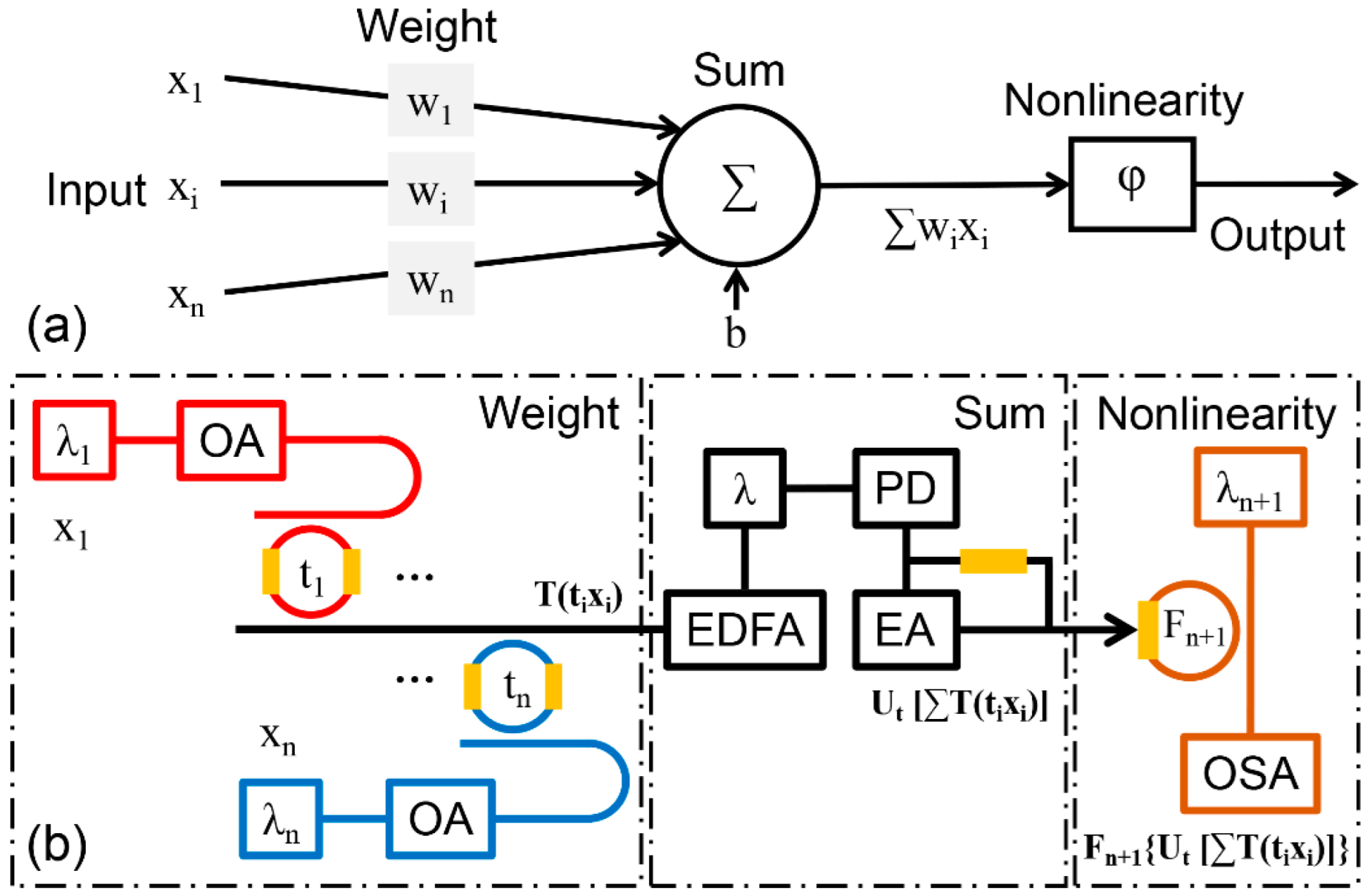
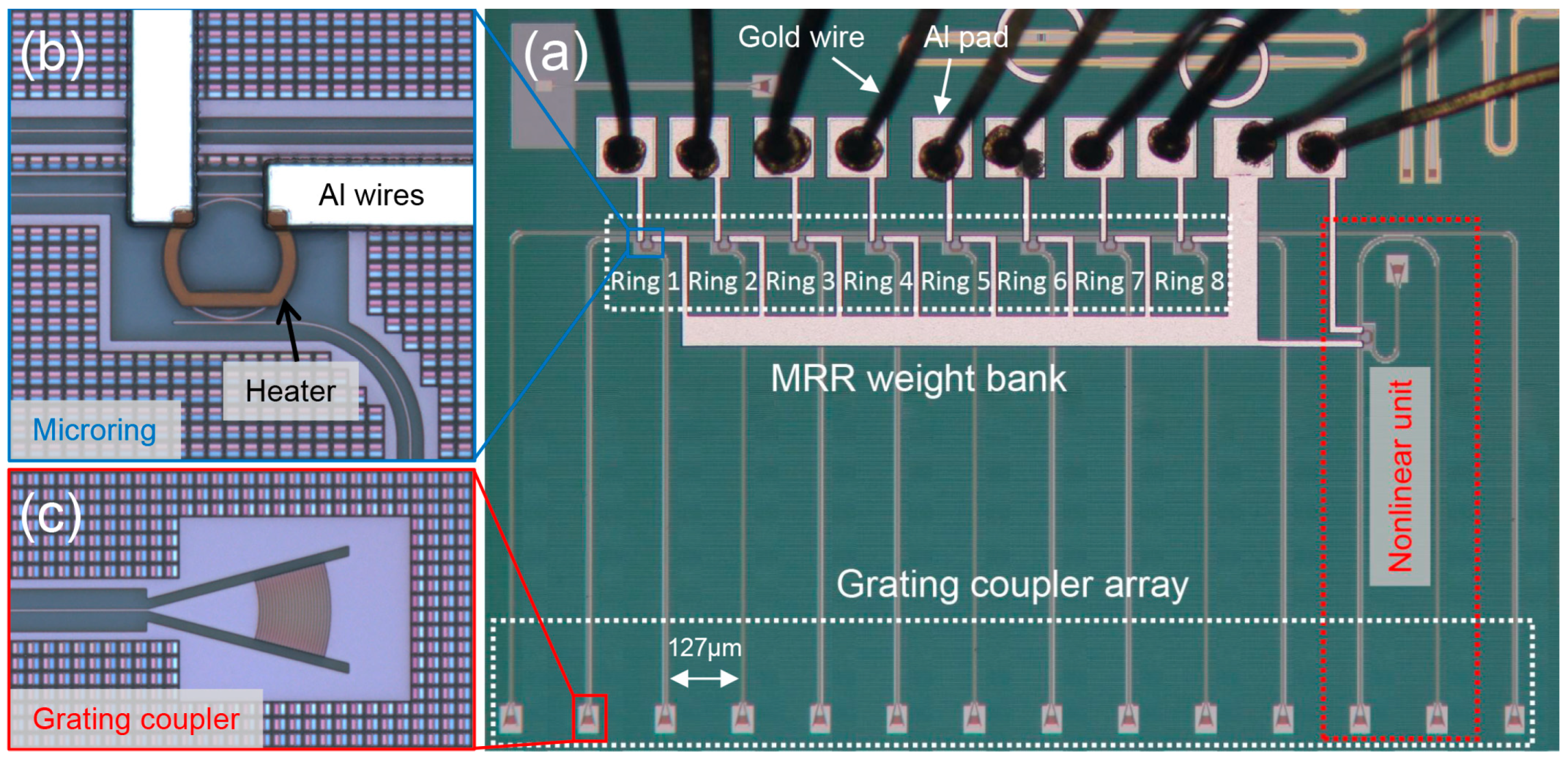

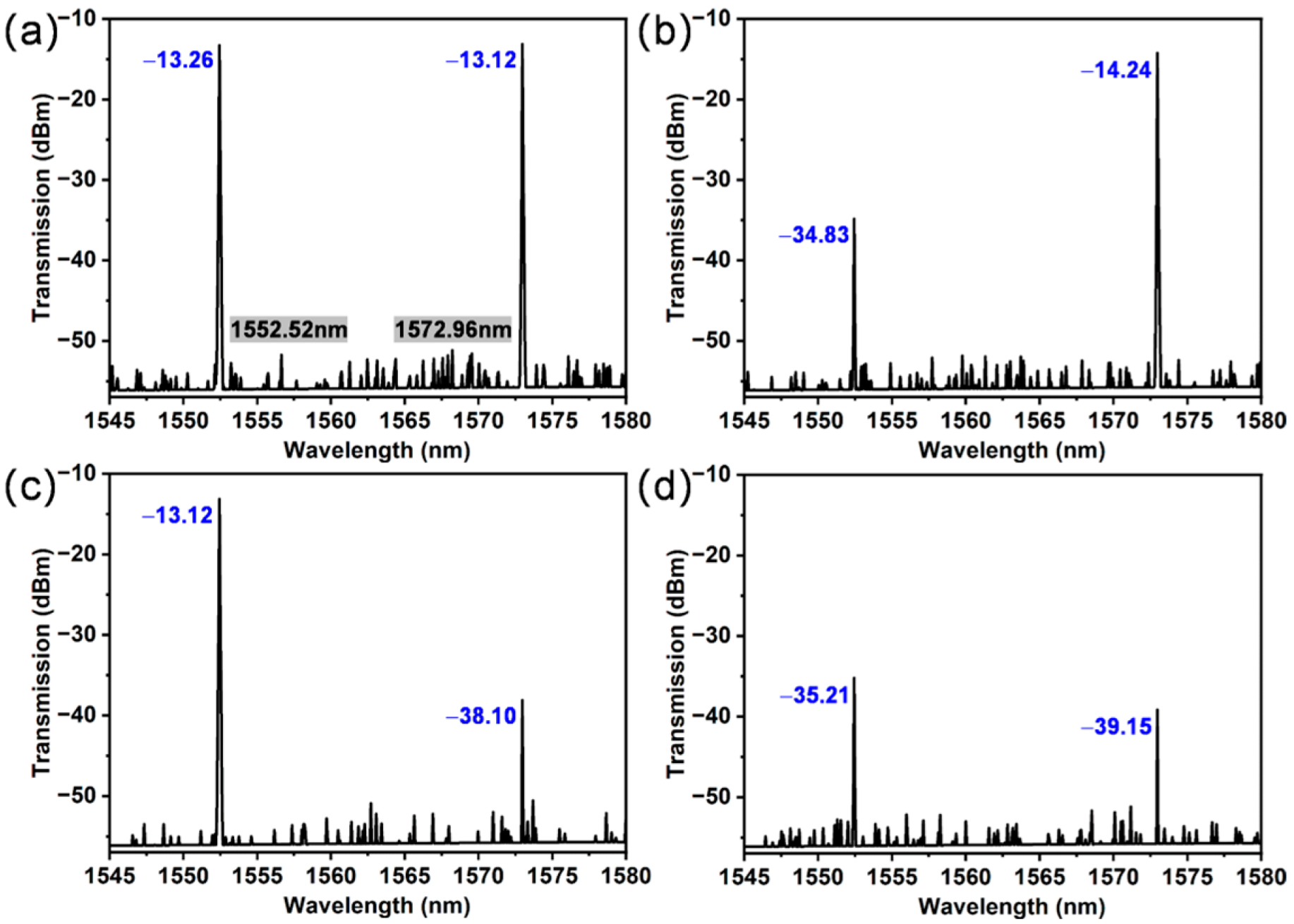


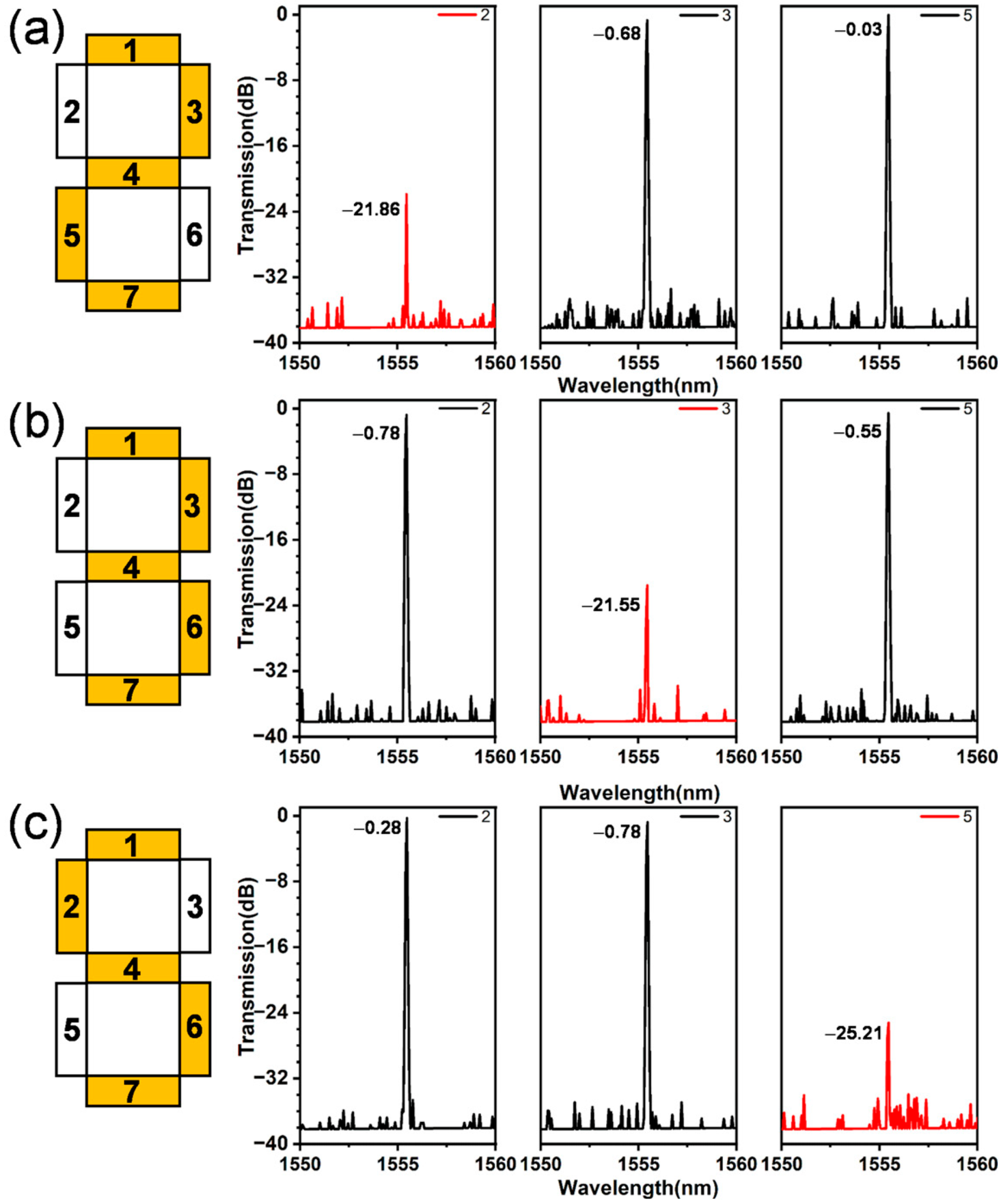
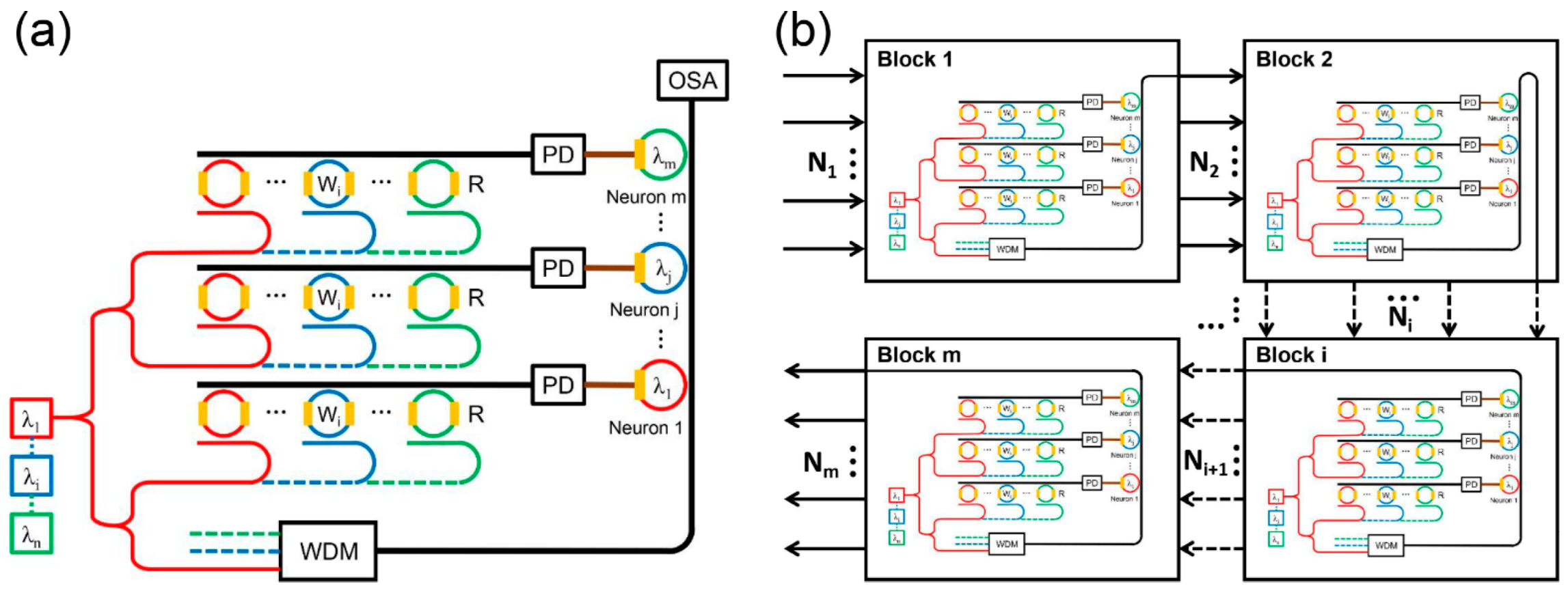
| Digit | Tube B | Tube C | Tube E | Tube F | Ring 3 | Ring 4 | Ring 6 | Ring 8 |
|---|---|---|---|---|---|---|---|---|
| 2 | 0 | 1 | 0 | 1 | 0 | 1 | 1 | 0 |
| 3 | 0 | 0 | 1 | 1 | 0 | 0 | 1 | 1 |
| 5 | 1 | 0 | 1 | 0 | 1 | 0 | 0 | 1 |
| Ref | Structure | MRRs’ Functions | Size | Computing Performance | ||
|---|---|---|---|---|---|---|
| Weight | Nonlinearity | Others | ||||
| [31] | MRR array | √ | - | - | 4 × 4 | 15 TOPS/W |
| [32] | Microcomb +MRRs | √ | - | Source | 1 × 4 | 1.04 TOPS/mm |
| [29] | Attenuator +MRR modulator | - | √ | - | 1 × 4 | 570 ps |
| [34] | MZI + MRR modulator | - | √ | - | 1 × 6 | 10 fJ/OP |
| This work | Thermally tunable MRRs | √ | √ | - | 1 × 4 | 10.41 mW |
Disclaimer/Publisher’s Note: The statements, opinions and data contained in all publications are solely those of the individual author(s) and contributor(s) and not of MDPI and/or the editor(s). MDPI and/or the editor(s) disclaim responsibility for any injury to people or property resulting from any ideas, methods, instructions or products referred to in the content. |
© 2025 by the authors. Licensee MDPI, Basel, Switzerland. This article is an open access article distributed under the terms and conditions of the Creative Commons Attribution (CC BY) license (https://creativecommons.org/licenses/by/4.0/).
Share and Cite
Zhang, H.; Huang, B.; Cheng, C.; Jiang, B.; Bao, L.; Xie, Y. On-Chip Silicon Photonic Neural Networks Based on Thermally Tunable Microring Resonators for Recognition Tasks. Photonics 2025, 12, 640. https://doi.org/10.3390/photonics12070640
Zhang H, Huang B, Cheng C, Jiang B, Bao L, Xie Y. On-Chip Silicon Photonic Neural Networks Based on Thermally Tunable Microring Resonators for Recognition Tasks. Photonics. 2025; 12(7):640. https://doi.org/10.3390/photonics12070640
Chicago/Turabian StyleZhang, Huan, Beiju Huang, Chuantong Cheng, Biao Jiang, Lei Bao, and Yiyang Xie. 2025. "On-Chip Silicon Photonic Neural Networks Based on Thermally Tunable Microring Resonators for Recognition Tasks" Photonics 12, no. 7: 640. https://doi.org/10.3390/photonics12070640
APA StyleZhang, H., Huang, B., Cheng, C., Jiang, B., Bao, L., & Xie, Y. (2025). On-Chip Silicon Photonic Neural Networks Based on Thermally Tunable Microring Resonators for Recognition Tasks. Photonics, 12(7), 640. https://doi.org/10.3390/photonics12070640






